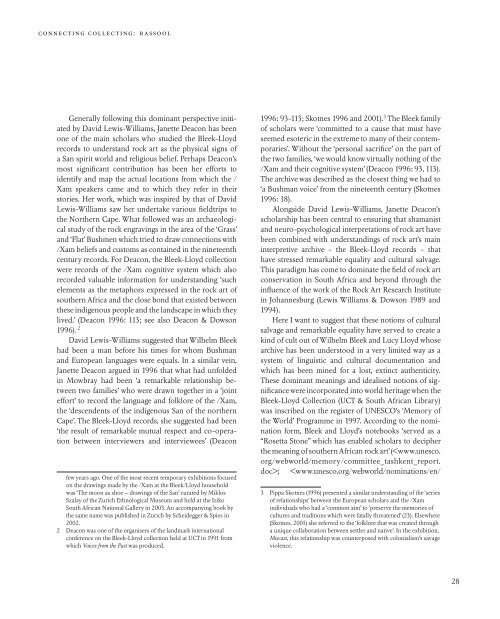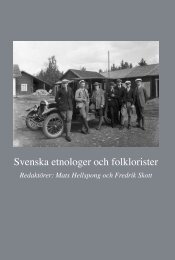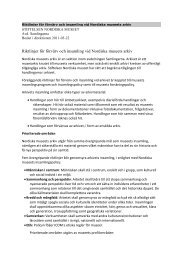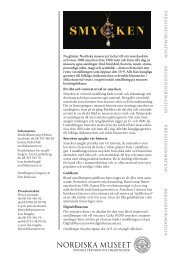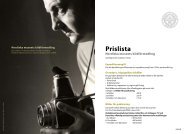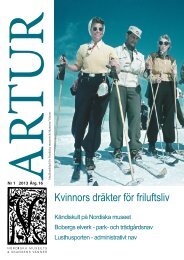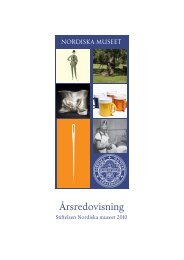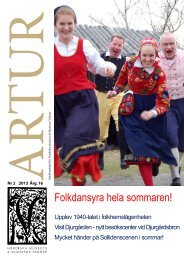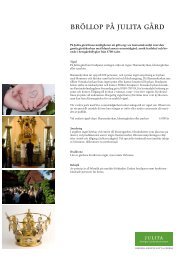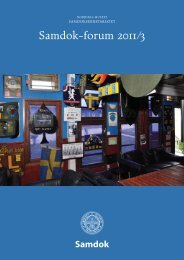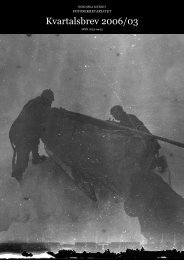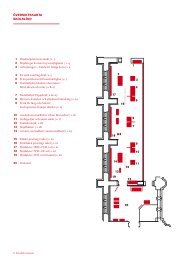Samdok - Nordiska museet
Samdok - Nordiska museet
Samdok - Nordiska museet
You also want an ePaper? Increase the reach of your titles
YUMPU automatically turns print PDFs into web optimized ePapers that Google loves.
connecting collecting: rassool<br />
Generally following this dominant perspective initiated<br />
by David Lewis-Williams, Janette Deacon has been<br />
one of the main scholars who studied the Bleek-Lloyd<br />
records to understand rock art as the physical signs of<br />
a San spirit world and religious belief. Perhaps Deacon’s<br />
most significant contribution has been her efforts to<br />
identify and map the actual locations from which the /<br />
Xam speakers came and to which they refer in their<br />
stories. Her work, which was inspired by that of David<br />
Lewis-Williams saw her undertake various fieldtrips to<br />
the Northern Cape. What followed was an archaeological<br />
study of the rock engravings in the area of the ‘Grass’<br />
and ‘Flat’ Bushmen which tried to draw connections with<br />
/Xam beliefs and customs as contained in the nineteenth<br />
century records. For Deacon, the Bleek-Lloyd collection<br />
were records of the /Xam cognitive system which also<br />
recorded valuable information for understanding ‘such<br />
elements as the metaphors expressed in the rock art of<br />
southern Africa and the close bond that existed between<br />
these indigenous people and the landscape in which they<br />
lived.’ (Deacon 1996: 113; see also Deacon & Dowson<br />
1996). 2<br />
David Lewis-Williams suggested that Wilhelm Bleek<br />
had been a man before his times for whom Bushman<br />
and European languages were equals. In a similar vein,<br />
Janette Deacon argued in 1996 that what had unfolded<br />
in Mowbray had been ‘a remarkable relationship between<br />
two families’ who were drawn together in a ‘joint<br />
effort’ to record the language and folklore of the /Xam,<br />
the ‘descendents of the indigenous San of the northern<br />
Cape’. The Bleek-Lloyd records, she suggested had been<br />
‘the result of remarkable mutual respect and co-operation<br />
between interviewers and interviewees’ (Deacon<br />
few years ago. One of the most recent temporary exhibitions focused<br />
on the drawings made by the /Xam at the Bleek/Lloyd household<br />
was ‘The moon as shoe – drawings of the San’ curated by Miklos<br />
Szalay of the Zurich Ethnological Museum and held at the Iziko<br />
South African National Gallery in 2003. An accompanying book by<br />
the same name was published in Zurich by Scheidegger & Spies in<br />
2002.<br />
2 Deacon was one of the organisers of the landmark international<br />
conference on the Bleek-Lloyd collection held at UCT in 1991 from<br />
which Voices from the Past was produced.<br />
1996: 93-113; Skotnes 1996 and 2001). 3 The Bleek family<br />
of scholars were ‘committed to a cause that must have<br />
seemed esoteric in the extreme to many of their contemporaries’.<br />
Without the ‘personal sacrifice’ on the part of<br />
the two families, ‘we would know virtually nothing of the<br />
/Xam and their cognitive system’ (Deacon 1996: 93, 113).<br />
The archive was described as the closest thing we had to<br />
‘a Bushman voice’ from the nineteenth century (Skotnes<br />
1996: 18).<br />
Alongside David Lewis-Williams, Janette Deacon’s<br />
scholarship has been central to ensuring that shamanist<br />
and neuro-psychological interpretations of rock art have<br />
been combined with understandings of rock art’s main<br />
interpretive archive - the Bleek-Lloyd records - that<br />
have stressed remarkable equality and cultural salvage.<br />
This paradigm has come to dominate the field of rock art<br />
conservation in South Africa and beyond through the<br />
influence of the work of the Rock Art Research Institute<br />
in Johannesburg (Lewis Williams & Dowson 1989 and<br />
1994).<br />
Here I want to suggest that these notions of cultural<br />
salvage and remarkable equality have served to create a<br />
kind of cult out of Wilhelm Bleek and Lucy Lloyd whose<br />
archive has been understood in a very limited way as a<br />
system of linguistic and cultural documentation and<br />
which has been mined for a lost, extinct authenticity.<br />
These dominant meanings and idealised notions of significance<br />
were incorporated into world heritage when the<br />
Bleek-Lloyd Collection (UCT & South African Library)<br />
was inscribed on the register of UNESCO’s ‘Memory of<br />
the World’ Programme in 1997. According to the nomination<br />
form, Bleek and Lloyd’s notebooks ‘served as a<br />
“Rosetta Stone” which has enabled scholars to decipher<br />
the meaning of southern African rock art’ (;


